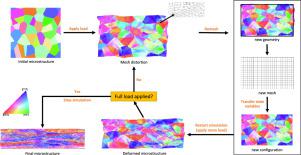International Journal of Plasticity ( IF 9.4 ) Pub Date : 2021-08-06 , DOI: 10.1016/j.ijplas.2021.103078 Karo Sedighiani 1, 2 , Vitesh Shah 1 , Konstantina Traka 1, 2 , Martin Diehl 1, 3, 4 , Franz Roters 1 , Jilt Sietsma 2 , Dierk Raabe 1

|
The capability of high-resolution modeling of crystals subjected to large plastic strain is essential in predicting many important phenomena occurring in polycrystalline materials, such as microstructure, deformation localization and in-grain texture evolution. However, due to the heterogeneity of the plastic deformation in polycrystals, the simulation mesh gets distorted during the deformation. This mesh distortion deteriorates the accuracy of the results, and after reaching high local strain levels, it is no longer possible to continue the simulation. In this work, two different adaptive remeshing approaches are introduced for simulating large deformation of 3D polycrystals with high resolution under periodic boundary conditions. In the first approach, a new geometry with a new mesh is created, and then the simulation is restarted as a new simulation in which the initial state is set based on the last deformation state that had been reached. In the second approach, the mesh is smoothened by removing the distortion part of the deformation, and then the simulation is continued after finding a new equilibrium state for the smoothed mesh and geometry. The first method is highly efficient for conducting high-resolution large-deformation simulations. On the other hand, the second method’s primary advantage is that it can overcome periodicity issues related to shear loading, and it can be used in conjunction with complex loading conditions. The merits of the methodologies are demonstrated using full-field simulations performed using a dislocation-density-based crystal plasticity model for Interstitial free (IF-) steel. Particular emphasis is put on studying the effect of resolution and adaptive meshing. The algorithms presented have been implemented into the free and open-source software package, DAMASK (Düsseldorf Advanced Material Simulation Kit).
中文翻译:

基于自适应网格划分的微观结构和微观纹理演化的大变形晶体塑性模拟
对承受大塑性应变的晶体进行高分辨率建模的能力对于预测多晶材料中发生的许多重要现象至关重要,例如微观结构、变形局部化和晶粒内织构演变。然而,由于多晶塑性变形的不均匀性,模拟网格在变形过程中会发生扭曲。这种网格变形会降低结果的准确性,并且在达到较高的局部应变水平后,将无法继续进行模拟。在这项工作中,引入了两种不同的自适应重新网格划分方法,用于在周期性边界条件下以高分辨率模拟 3D 多晶的大变形。在第一种方法中,创建具有新网格的新几何体,然后模拟重新开始作为新的模拟,其中基于已达到的最后变形状态设置初始状态。在第二种方法中,通过去除变形的扭曲部分来平滑网格,然后在为平滑的网格和几何体找到新的平衡状态后继续模拟。第一种方法对于进行高分辨率大变形模拟非常有效。另一方面,第二种方法的主要优点是它可以克服与剪切加载相关的周期性问题,并且可以与复杂的加载条件结合使用。使用基于位错密度的晶体塑性模型对无间隙 (IF-) 钢进行的全场模拟证明了这些方法的优点。特别强调研究分辨率和自适应网格划分的影响。所提供的算法已在免费和开源软件包 DAMASK(杜塞尔多夫高级材料模拟套件)中实现。











































 京公网安备 11010802027423号
京公网安备 11010802027423号